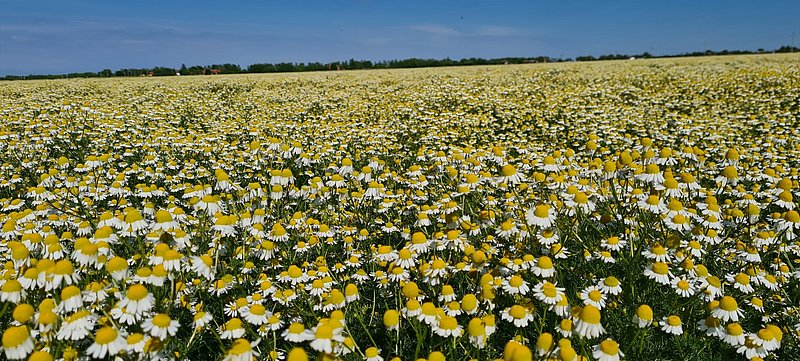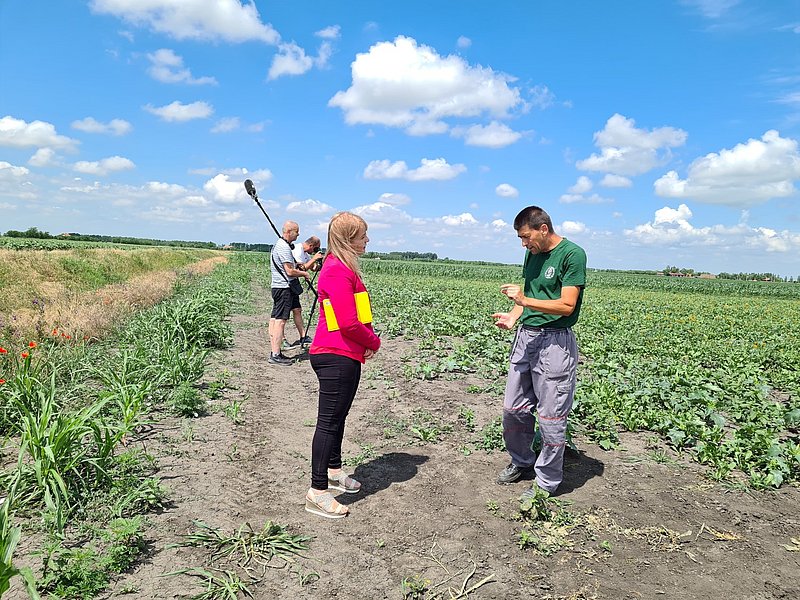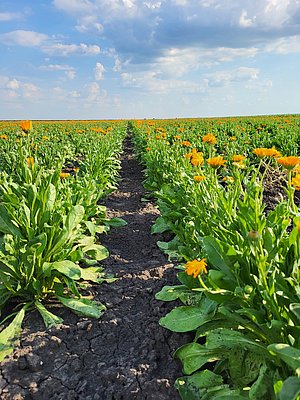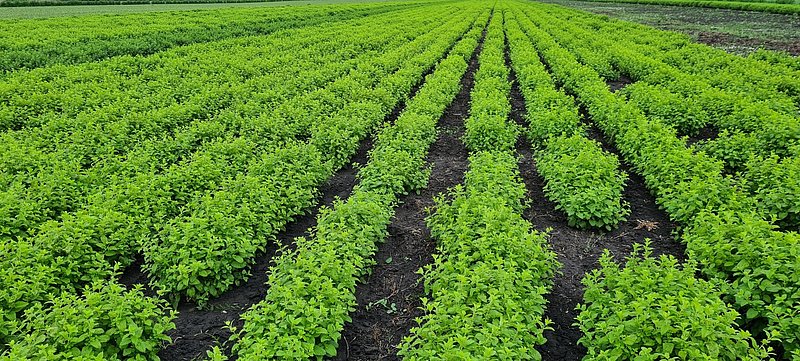
Herbs for medicine and cosmetics according to organic standards
Zoltan Kurunci’s farm is located in the Banat region in the northern part of Serbia, east of the river Tisa. The nearest largest city is Kikinda. This region has always been known for the cultivation of medicinal herbs. Zoltan Kurunci and his brother cultivate medicinal herbs like chamomile, mint or thyme organically.

terraHORSCH: Since 2010 you have been working for HORSCH as the responsible sales manager for Serbia, Croatia and Slovenia. How did you come up with the idea of cultivating medicinal herbs?
Zoltan Kurunci: About 10 years ago, I cultivated approx. 260 hectares of arable land. Most of it was leased from the government. I originally grew maize, wheat, barley and rape. However, within the scope of the so-called restitution process the Serbian government eventually decided to return the land to the previous owners. Thus, I had less and less land to cultivate and I decided that I only wanted to work on my own land. I wanted to go back to the roots and thus, I quickly came up with the idea of cultivating medicinal herbs. But only according to organic standards – completely without pesticides or fertiliser. The climate in our region is excellent for this purpose and farmers had been cultivating medicinal herbs here before.
Since 2017 I have been running the farm with 110 hectares together with my brother. We started with 3 hectares. In the meantime, we cultivate 25 hectares according to organic standards, 10 more hectares are being converted at the moment. In Europe, this conversion phase takes three years. During this time no mineral fertiliser or other chemical products are used but the status “Organic” is not yet granted. After three years, you will get the status “Organic”.
terraHORSCH: How do you get the organic certification seal in Serbia?
Zoltan Kurunci: There are several agency-recognized certification companies. I for example co-operate with the subsidiary of a Dutch company. They accompany and assist you respectively control everything on site. First of all, you have to complete loads of forms and documents, for every step has to be documented. Even the seed has to be certified according to organic standard. And you have to specify which kind of tillage you carry out. Once or twice a year there is an official visit to take a look at everything respectively to check if the requirements are met. Logically, you are not allowed to use chemical products or mineral fertiliser. To supply the plants with nutrients, I therefore use small pellets to feed the bacteria in the soil. They in turn supply the herbs by transforming organic matter into plant food. These pellets are applied in autumn as the soil has to be slightly wet. This is the only way to achieve utmost efficiency. If you meet all requirements, you will get the certificate after approx. two to three months. But that’s not the end of it. I always say a certificate is a key that opens some doors. For if after the analysis pesticide residues are found, there is no chance to sell anything. We first carry out our own analysis, then send the samples to the customer who checks it again. If everything is ok, you can sell the product with organic standard.
terraHORSCH: Which medicinal herbs do you cultivate, and which sectors do you mainly sell your products to?
Zoltan Kurunci: Among others we grow chamomile, mint, balm as well as thyme or marigold. Marigold is mainly sold to cosmetics companies as it is ideal for creams etc. Moreover, we sell a lot of our products to customers that produce tea. However, when I started in 2017, I originally wanted to mainly produce essential oils from the crops. But I quickly noticed that the produced quantities were too small to be exported. In Serbia, there is no big market for essential oils.
terraHORSCH: By now, you are selling your own tea, aren’t you?
Zoltan Kurunci: Yes, and I am very proud of it. So far, we have only been selling our tea in the domestic market in co-operation with some shops that sell organic products. Among others we provide thyme, balm, mint and chamomile in 20 g packs my wife designed with a great love for details. And the great thing is that you only need very few blossoms for one infusion. If you take one teaspoon, the tea will be too strong. This speaks in favour of our quality. With our 20 g pack you can brew five times more tea than with the tea bags from the supermarket. And we received the Serbian as well as the European organic certificate for our herbal teas. We are still just getting started but I hope that we will be able to expand this line of business.
terraHORSCH: Can you describe the characteristics of your fields and the machines you use?
Zoltan Kurunci: With a clay content of approx. 40 % our soils are very heavy. Thus, tillage is a challenge, and the soils are very sensitive when it is wet. But I found a solution. For when I started to work for HORSCH I suddenly got insights into new cultivation possibilities.
For primary tillage I use a Terrano 3 FX which is one of the most important machines on my farm. In addition, I have a Joker 3 CT as well as a subsoil loosener. This subsoil loosener is important, especially in years with a lot of rain. Soil compaction then is enormous because of the high clay share, and you have to guarantee the gas exchange. We have been working with the Terrano FX for quite some years and there no longer is a blue layer. But it still is necessary to loosen the subsoil every three to four years.

terraHORSCH: What are the individual steps for preparing the soil?
Zoltan Kurunci: Before 2010 I only used a plough for tillage. But this takes really long – for one hectare it takes you at least two hours or more to turn the soil. With my Terrano 3 FX which allows for an operational speed of 9 km/h I am much faster. This is definitely one of the main advantages of this machine.
In spring we start with a shallow pass with a seedbed cultivator. We need a very good soil with an extremely fine structure. For the seeds of medicinal herbs are very fine and small. The tillage pass with the Terrano FX provides the desired conditions.
Some medicinal herbs remain on the fields for 4, 5 or 6 years, and there is no rotation. For the chamomile there is a rotation every year. We harvest it at the end of May, beginning of June to have enough time to sow other crops. After the harvest of the chamomile blossoms there are no major residues on the field, it is very easy to handle – one pass with the Joker 3 CT and the field more or less is ready for sowing.
In the first years I used an Express 3 TD for sowing – the machine is ideal for our conditions. With the special metering roller with 2.8 cm³ I was able to sow 200 g per hectare. Especially special herbs like thyme can be applied excellently. The Express is easily adjustable and therefore ideal for this kind of herbs. The seed is placed about 1 cm deep into the soil. This is important as these crops do not emerge if they are placed too deeply. Especially for chamomile it is crucial to sow at the surface. The seeds are very small, require sunlight to emerge but also the capillarity respectively water from below. Therefore, it is necessary to press the soil after it has been prepared in September. As our soils are very heavy, I compact them with the tractor tyres. The seeds then are placed into the tyre profile as they are then protected against the wind. In addition, capillarity is best here as it is the highest point of the consolidation. I already tried to sow with the Pronto, but the pressure was not enough.
Since last year I have also been using the Taro 6 SL for sowing. Previously, I prepared the surface with the Joker 3 CT. However, I quickly noticed that for our fields it was too large. This is why I now also ordered a Versa 3 KR. This machine allows for changing the row spacings in an uncomplicated way. For some of our crops we need 15 cm, for others 30 cm or 45 cm. Moreover, the rotary harrow in front of the seed units guarantees a very fine, good structure.
The high quality of our products is due to a combination of our good soils, the climate and the varietal selection. If there is more sun or if the weather is hot, the plant produces more oil to protect itself from drought and the sun.

terraHORSCH: What is the greatest challenge when growing medicinal herbs?
Zoltan Kurunci: The biggest challenge for this kind of organic farming is the weed management as you are not allowed to use chemical products. It is not easy to remove weeds manually if there is not enough staff. In this respect, we face the same problem as other countries. This is why we use different harrows in spring like for example our Cura. With the Cura I carry out the first tillage pass and then I drive over the fields every second or third day to remove the small plants. If it rains, we cannot work in the field. In this case, the weeds grow by up to 3-5 cm within a few days. If they are 5 cm high this usually means that the root, too, is 5 cm deep. You are no longer able to take it out with the harrow. We then have to do it manually. This takes a lot of time and ties up labour. Chamomile for example is normally sown in the middle of October so that the plant can develop until winter and a green carpet emerges. This reduces problems for it starts to grow on the first sunny days in February whereas the weeds still sleep – the latter normally emerge in the second half of March. The chamomile plant is so strong that is it very easy to handle.
Moreover, it is important to have some kind of buffer zone to protect one’s own crops if the neighbours use chemical products. I plant scrubs and bushes to shield my fields.
terraHORSCH: These bushes surely need a certain height to provide an efficient protection?
Zoltan Kurunci: At any rate, they should be higher than the cultivated crops. Among others I use a bush from Siberia that can grow to a height of approx. 1.5 m per year. The objective is to let them grow to a height of 2 m. Of course, it is easier to protect the large lots than the small ones. Currently I have a field with 12 hectares and one with 9 hectares.
terraHORSCH: How do you harvest the herbs?
Zoltan Kurunci: We harvest them with a special trailed harvester. Marigold partly is picked manually, as you thus achieve a yield that is twice as high compared to harvesting with a machine. With a combine you can carry out three harvests at most as with this method the small blossoms are destroyed. This is the reason why everything we pick manually is sown with a row spacing of 45 cm. If the harvest is carried out with a combine, we use a row spacing of 15 cm. This is why the Versa is so ideal for our requirements as we are much more flexible.
terraHORSCH: After the harvest, what happens with the herbs to prepare them for sales respectively shipment?
Zoltan Kurunci: It depends on the respective plant. With the chamomile for example the first step is to separate the blossom from the remaining green elements like the leaves. After that the blossoms are put into a dryer. In this step, we have to be very careful as we want to keep the essential oil in the plant. Thus, the air temperature during the drying process must not be higher than 42 to 43 degrees. In our case, the process takes between 8 to 9 hours. Normally, the drying time amounts to 16 to 18 hours. It took a long optimisation process and a lot of sleepless nights until we managed to reduce the drying time.
terraHORSCH: What are you doing differently?
Zoltan Kurunci: There is not much leeway with regard to temperature – it has to be constant. But we noticed that every cubic metre of air absorbs a certain amount of moisture. So we exchange the air. However, you must not press too much air into the system as otherwise the material starts to fly. With this process you can bring two and a half times more air into the dryer and thus, the drying process can be shortened.
After drying the chamomile is put into a machine that separates the heads from the stems. Then all the components that are not required are sorted out manually by the employees. Finally, everything is put into a wind tunnel where the chamomile blossoms can be separated according to their weight. Thus, you obtain two different grades. During this process some blossoms lose their pollen which, in my opinion, is the best part of the whole product. When I make tea at home, I never use the blossoms but the powder. Unfortunately, you do not get the best price on the market for this part of the plant.
Mint or balm are put into the dryer directly after the harvest, then the leaves are separated from the stems. The stems return to the fields as organic matter and the leaves are put on different kinds of vibrating tables to separate them into different fractions. For some customers want larger leaves, some want smaller ones.
